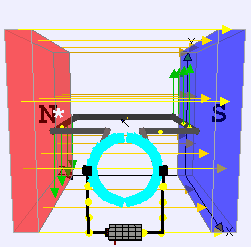...
- If an electric charge moves, it generates its own magnetic field, which interacts with the original field (from permanent magnets)
- Hence, a magnetic field exerts a force on a moving electric charge
- A DC motor uses a permanent magnet to exert a force on a current-carrying coil of wire
- The direction in which the coil of wire moves can be found using Fleming’s left hand rule
- Easy DIY DC Motor https://www.youtube.com/watch?v=DsZCW34LktU
- DC motors are used in applications which require good energy efficiency, but only imprecise control. Control, if necessary, has to be achieved through some external control mechanism
- Used in fans, drills, traction etc.
Here is a good interactive tutorial on DC motors - https://nationalmaglab.org/education/magnet-academy/watch-play/interactive/dc-motor
Torque and Speed
- The equivalent of force for rotation is called Torque
- Higher torque applied to the wheel = better ability to overcome obstacles / friction, climb up a slope etc.
- Usual DC motors run at very high rpm, but produces very low torque – typically not enough to run a robot
- We use gears to increase the torque, but this comes at the expense of speed
...


